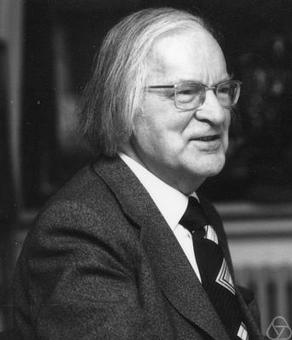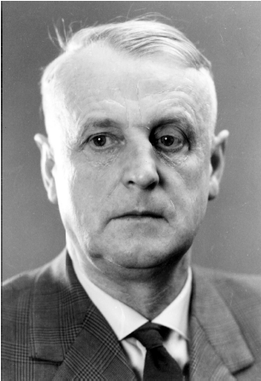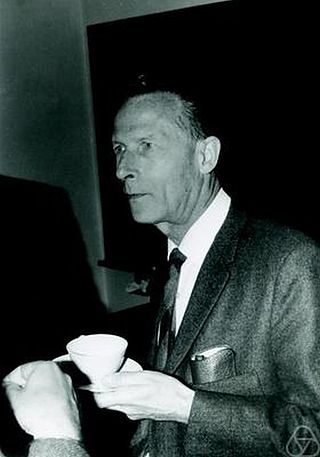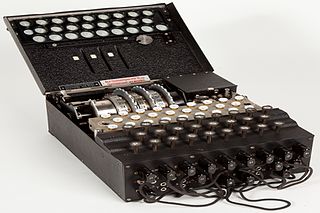Related Research Articles

Willi Ludwig August Rinow was a German mathematician who specialized in differential geometry and topology. Rinow was the son of a schoolteacher. In 1926, he attended the Humboldt University of Berlin, studying mathematics and physics under professors such as Max Planck, Ludwig Bieberbach, and Heinz Hopf. There, he received his doctorate in 1931. In 1933, he worked at the Jahrbuch über die Fortschritte der Mathematik in Berlin. In 1937, he joined the Nazi Party. During 1937—1940, he was an editor of the journal Deutsche Mathematik. In 1937, he became a professor in Berlin and lectured there until 1950. His lecturing was interrupted because of his work as a mathematician at the Oberspreewerk in Berlin from 1946 to 1949.
Iris Anna Runge was a German applied mathematician and physicist.
The Cipher Department of the High Command of the Wehrmacht was the Signal Intelligence Agency of the Supreme Command of the Armed Forces of the German Armed Forces before and during World War II. OKW/Chi, within the formal order of battle hierarchy OKW/WFsT/Ag WNV/Chi, dealt with the cryptanalysis and deciphering of enemy and neutral states' message traffic and security control of its own key processes and machinery, such as the rotor cipher ENIGMA machine. It was the successor to the former Chi bureau of the Reichswehr Ministry.
The Pers Z S was the signals intelligence agency of the German Foreign Office before and during World War II. It consisted of two cryptologic sections. Pers Z S was the cryptanalytic section which was called Special Service of Z Branch of the Foreign Office Personnel Department. Its mission was the solution of foreign diplomatic codes and ciphers. The other section, which was the Cryptography Section was called Personal Z Cipher Service of the Federal Foreign Office. The latter section was responsible for compilation, distribution and security of Foreign Office codes and ciphers. Both were colloquially known as Pers Z S. Though similar in nature and operation to the OKW/Chi cipher bureau, it was a civilian operation as opposed to the military operation at OKW/Chi and focused primarily on diplomatic communications. According to TICOM interrogators it evinced an extraordinary degree of competence, primarily driven by a consistency of development not found in any other German signals bureau of the period. Pers Z S/Chi was the symbol and the code name of the Chiffrierdienst, i.e. the Cryptanalysis Department of Pers Z S. Although little is known about the organization, in the final analysis, Pers Z S labored at diplomatic cryptanalysis for a regime for which there were no diplomatic solutions.

Hans Rohrbach was a German mathematician. He worked both as an algebraist and a number theorist and later worked as cryptanalyst at Pers Z S, the German Foreign Office cipher bureau, during World War II. He was latterly known as the person who broke the American diplomatic O-2 cypher, a variant of the M-138-A strip cipher during 1943. Rohrbach wrote a report on the breaking of the strip cypher when he was captured by TICOM, the allied effort to roundup and seize captured German intelligence people and material.

Karl Walter Schröter was a German mathematician and logician. Later on, after the war, he made important contributions concerning semantic consequences and provability logic. He worked as a mathematical theoretician and cryptanalyst for the civilian Pers Z S, the cipher bureau of the Foreign Office, from the spring of 1941 to the end of World War II.
General der Nachrichtenaufklärung was the signals intelligence agency of the Heer, before and during World War II. It was the successor to the former cipher bureau known as Inspectorate 7/VI in operation between 1940 and 1942, when it was further reorganised into the Headquarters for Signal Intelligence between 1942 and 1944, until it was finally reorganised in October 1944 into the GdNA. The agency was also known at the OKH/Gend Na, GendNa or Inspectorate 7 or more commonly OKH/GdNA. Inspectorate 7/VI was also known as In 7 or In/7 or In 7/VI and also OKH/Chi.
Otto Buggisch was a German mathematician who, during World War II, was a cryptanalyst working in the cipher bureau, the Cipher Department of the High Command of the Wehrmacht (OKW/Chi) responsible for deciphering of the opposing forces Communications. He also dealt with the security control of own key procedures. Through research and revelations exposed by two Polish officers, late in the war, he recognized the true cryptographic weaknesses of the Enigma rotor cipher, key machine used by the German armed forces to encrypt their secret communications, in World War II.
Wolfgang Franz was a German mathematician who specialised in topology particularly in 3-manifolds, which he generalized to higher dimensions. He is known for the Reidemeister–Franz torsion. He also made important contributions to the theory of lens spaces.

Alexander Aigner was an Austrian mathematician specialising in number theory, and a full university professor of mathematics at the Karl Franzens University in Graz. During World War II he was part of a group of five mathematicians, which was recruited by the military cryptanalyst Wilhelm Fenner, and which included Ernst Witt, Georg Aumann, Oswald Teichmueller and Johann Friedrich Schultze, to form the backbone of the new mathematical research department in the late 1930s, which would eventually be called Section IVc of Cipher Department of the High Command of the Wehrmacht.. The group was led by the German professor of mathematics Wolfgang Franz.

Alfred Emil Richard Kneschke was a German mathematician, engineer and university lecturer. During the World War II, Kneschke managed the Referat IV, Section II of the Wehrmacht Signals intelligence organization General der Nachrichtenaufklärung until November 1944, working on cryptanalysis and decoding of British, USA, French and Balkan cipher systems. From Nov 1944, he worked in the OKW/Chi cipher bureau as a cryptanalyst.
Friedrich Böhm was a German actuarial and insurance mathematician and university lecturer. During World War II, Böhm was conscripted into Group IV of Inspectorate 7, an early cipher bureau and Signals intelligence agency of the German Army (Wehrmacht), working to decode foreign Ciphers. He would later work in the successor organization: General der Nachrichtenaufklärung, in a similar role.
Johannes Anton Marquart was a German actuarial and insurance mathematician. During World War II, Marquart was employed into the Germany Army Inspectorate 7/VI, in 1940, which later became the General der Nachrichtenaufklärung. He eventually became head of Referat Ia of Group IV of the organization in November 1944 engaged in research into German Army hand cryptographic systems. Prior to that period Marquart had been chief cryptanalysis in KONA 5.

Rudolf Paul Joachim Kochendörffer was a German mathematician and professor of mathematics in the University of Rostock specialising in algebra, group theory and theory of finite groups and their representation. During World War II, Kochendörffer worked as a mathematical cryptanalyst in the mathematical referat of Inspectorate 7/IV, that would later become part of Referat I of Group IV of the General der Nachrichtenaufklärung, the signals intelligence agency of the Wehrmacht and was known as a cryptographic tester of the Enigma cipher machine. Kochendörffer was a Member of the Scientific Advisory Council for Mathematics at the State Secretariat for the Higher and Specialist Schools of the GDR, a staff member of Mathematical Reviews and collaborated with the Zentralblatt MATH

Wilhelm Vauck was a German mathematician, physicist and university lecturer in physics and electrical engineering. During World War II, Vauck was the director of the agents Referat within the Funkabwehr, the German Armies radio counter-intelligence organisation. As an anti-nazi, Vauck's work on the discovery of the Rote Kapelle anti-fascist resistance group during World War II, burdened him deeply until the end of his life.
Hans Karl Georg Heinrich Pietsch was a German mathematician who was most notable for being a director of the Mathematical Referat of the Wehrmacht signals intelligence agency, the General der Nachrichtenaufklärung during World War II.
Hans-Peter Luzius was a German actuarial mathematician and economist. Luzius was most notable for his work during World War II on researching a method to cryptanalyse the M-209 mechanical cipher machine that led to the first recovery of key based on a crib, while he was conscripted to the Inspectorate 7/VI, the signals intelligence agency of the Wehrmacht, while based at Matthäikirchplatz in Berlin, close to Bendlerblock.
Rudolf Schauffler was a German mathematician, who was most notable for being the nominal head of the Linguistics and Cryptanalysis section of Pers Z S, the Signal Intelligence Agency of the German Foreign Office before and during World War II.

German Army cryptographic systems of World War II were based on the use of three types of cryptographic machines that were used to encrypt communications between units at the division level. These were the Enigma machine, the teleprinter cipher attachment, and the cipher teleprinter the Siemens and Halske T52,. All were considered insecure.

Eberhard Hermann Erich Zeidler was a German mathematician, who worked primarily in the field of non-linear functional analysis.
References
- ↑ Herbert von Denffer at the Mathematics Genealogy Project
- 1 2 3 4 Humboldt University of Berlin Archive File: HU/UA Phil. Fak. 769
- ↑ "TICOM I-58 Interrogation of Dr Otto Buggisch of OKW/Chi 8th August 1945" (PDF). TICOM. p. 9. Retrieved 29 January 2018.